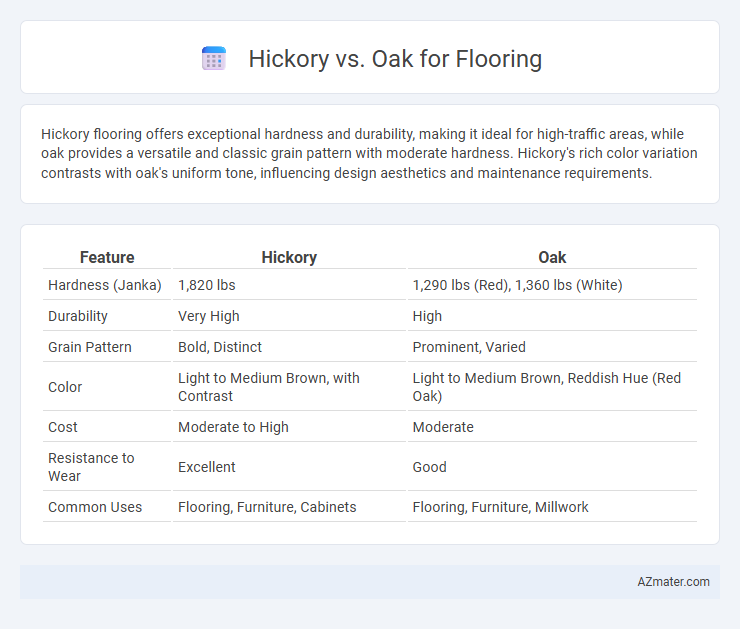Hickory flooring offers exceptional hardness and durability, making it ideal for high-traffic areas, while oak provides a versatile and classic grain pattern with moderate hardness. Hickory's rich color variation contrasts with oak's uniform tone, influencing design aesthetics and maintenance requirements.
Table of Comparison
| Feature | Hickory | Oak |
|---|---|---|
| Hardness (Janka) | 1,820 lbs | 1,290 lbs (Red), 1,360 lbs (White) |
| Durability | Very High | High |
| Grain Pattern | Bold, Distinct | Prominent, Varied |
| Color | Light to Medium Brown, with Contrast | Light to Medium Brown, Reddish Hue (Red Oak) |
| Cost | Moderate to High | Moderate |
| Resistance to Wear | Excellent | Good |
| Common Uses | Flooring, Furniture, Cabinets | Flooring, Furniture, Millwork |
Introduction to Hickory and Oak Flooring
Hickory and oak are two popular hardwood options for flooring known for their durability and distinct grain patterns. Hickory features a unique combination of light and dark streaks, offering a rustic yet bold aesthetic, while oak provides a more traditional, consistent grain with warm reddish or brown tones. Both woods have high hardness ratings, with hickory rated around 1820 on the Janka hardness scale and oak averaging between 1290 and 1360, making them ideal for high-traffic areas.
Key Differences Between Hickory and Oak Wood
Hickory wood is denser and harder than oak, making it more resistant to dents and scratches, ideal for high-traffic flooring areas. Oak features a more uniform grain pattern and a smoother texture, which enhances its versatility in design and finish options. While hickory offers a more rustic and varied appearance with its natural color variations, oak provides a classic, elegant look with consistent tones that complement both traditional and modern interiors.
Durability and Hardness Comparison
Hickory and oak are both popular hardwood choices for flooring, with hickory ranking higher in hardness on the Janka scale at approximately 1820 compared to red oak's 1290, making hickory more resistant to dents and wear. Hickory's superior density and toughness provide greater durability in high-traffic areas, while oak offers solid hardness with enhanced stability and a classic, versatile grain pattern. Flooring durability and hardness preferences depend on traffic intensity and aesthetic requirements, with hickory favored for extreme durability and oak chosen for balanced hardness and traditional appeal.
Appearance and Aesthetic Appeal
Hickory flooring showcases a striking variation in grain patterns with bold streaks and knots, creating a rustic and dynamic appearance that adds character to any space. Oak flooring offers a more uniform grain with subtle texture, delivering a classic, timeless aesthetic that complements both traditional and modern interiors. Both woods provide warm tones, but hickory's high contrast and natural hues make it ideal for statement floors, while oak's consistent look ensures versatility and elegance.
Cost and Budget Considerations
Hickory flooring generally costs between $5 to $9 per square foot, making it a more budget-friendly option compared to oak, which ranges from $6 to $12 per square foot depending on the species. Hickory's durability and distinctive grain patterns provide excellent value for homeowners seeking affordable yet long-lasting hardwood floors. Oak floors require a higher initial investment but offer a classic aesthetic and may increase property value, especially with red or white oak varieties.
Installation Process and Challenges
Hickory flooring requires careful acclimation and precise moisture control during installation due to its high density and natural hardness, which can cause expansion and contraction issues if not managed properly. Oak, being more stable and less dense, offers a smoother installation process with fewer risks of warping or cupping, making it preferable for DIY projects and uneven subfloors. Both require professional-grade tools and fasteners, but Hickory's tougher surface demands more labor-intensive cutting and nailing, increasing installation time and complexity compared to Oak.
Maintenance and Longevity
Hickory flooring offers exceptional durability and resistance to wear, making it ideal for high-traffic areas, though it requires regular cleaning and occasional refinishing to maintain its appearance. Oak flooring, known for its hardness and stability, demands less frequent maintenance but benefits from periodic polishing to enhance its natural grain. Both hardwoods provide long-lasting flooring solutions, with oak typically offering slightly longer lifespan under normal residential use.
Environmental Impact and Sustainability
Hickory flooring offers a sustainable option due to its rapid growth rate and widespread availability, reducing deforestation pressures compared to slower-growing hardwoods like oak. Oak, while durable and long-lasting, often comes from older, slower-growing trees, which can increase environmental impact through longer regeneration periods. Both woods can be sourced responsibly through certified programs such as FSC, but hickory's faster renewability generally supports a lower ecological footprint in flooring applications.
Best Applications and Room Suitability
Hickory flooring offers exceptional hardness and durability, making it ideal for high-traffic areas like kitchens, hallways, and living rooms where resilience is crucial. Oak floors, especially red and white varieties, provide versatile aesthetics and moderate hardness suitable for bedrooms, dining rooms, and offices that benefit from a warm, classic look. Both woods perform well with radiant heating but hickory's rustic, bold grain suits farmhouse or rustic styles, while oak's smoother texture complements traditional and contemporary interiors.
Final Recommendation: Hickory vs Oak for Your Floors
Hickory offers superior hardness and durability, making it ideal for high-traffic areas and homes with pets or children. Oak provides a classic, versatile grain pattern and slightly easier installation, suited for traditional or modern interior styles. Choose hickory for long-lasting resilience and oak for cost-effective, timeless appeal in your flooring project.

Infographic: Hickory vs Oak for Floor
 azmater.com
azmater.com